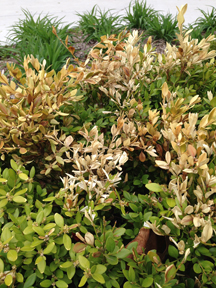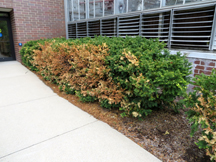Purdue experts offer advice on plants damaged from harsh winter
May 12, 2014
 |
|
Boxwood have experienced dieback due to cold injury and desiccation, a condition from plant tissue losing too much water. (Purdue Department of Botany and Plant Pathology photo/Gail Ruhl) |
WEST LAFAYETTE, Ind. - Extreme cold last winter, unrelenting winds and unusually large amounts of salt that were applied to roads, sidewalks and parking lots are taking their toll on landscape plants this spring, a group of Purdue University experts say.
They are seeing considerable damage and expect more this summer and beyond. While it is difficult to determine winter injury until bud break, they say it is now time for homeowners and others with ornamental plants to evaluate their plants for damage that needs to be corrected.
"As plants awakened from their winter slumber, you may have noticed some branches that exhibited dieback or plants that failed to flower or leaf out," they say in an article, "The Revealing Effects of Winter on Trees and Shrubs," posted at https://ag.purdue.edu/hla/Extension/nle/
Articles/TheRevealingEffectsofWinteron
TresandShurbs.pdf. "Be sure to practice good cultural practices this spring to help injured plants recover and provide good growing conditions going into the summer."
The authors explain how last winter's severe conditions might have seriously damaged garden and other landscape plants, and they offer advice on how to best help them recover. The article was written by Kyle Daniel, Rosie Lerner, Gail Ruhl, Lindsey Purcell, Janna Beckerman and Tom Creswell.
Plants such as crape myrtle that are marginally winter-hardy in specific areas have survived winters of relatively mild temperatures. But the authors say such plants could die or sustain damage including dieback to the ground as a result of the harsh winter.
"Also, plants that were already stressed due to other factors, such as disease or the extreme drought of 2012, will be especially vulnerable to the extremes of this past winter, " they say.
 |
|
Yews are extremely susceptible to salt damage, causing a burn injury similar to winter injury. (Purdue Department of Botany and Plant Pathology photo/Gail Ruhl) |
But the authors note that plants that have evolved in temperate zones such as the Midwest protect themselves from freezing temperatures by going dormant. During that period, they are at their most cold-hardy condition of the season.
"So little damage is expected to normally 'healthy' plants or those plants that entered the cold season without duress," they say.
Although plants are dormant during the winter months, the authors note that plant tissue still is subject to losing too much water - a condition called desiccation - especially from frigid temperatures and strong winds. Evergreens, especially broadleaved evergreens such as Rhododendron, Mahonia boxwood and holly, are the most susceptible because they have greater leaf surface area through which to lose water compared with deciduous plants, which have no leaves during dormancy.
"This year's unusually heavy and consistent snow cover provided good insulation, and most plants went into winter with a good moisture supply," they write. "However, when the ground is frozen solid and freezing temperatures are accompanied by high winds, the plants continue to lose moisture through transpiration without being able to replenish the supply."
Plants such as yew also could be damaged from salt and other chemicals that were frequently applied to roadways, sidewalks and parking lots. Such damage resembles drought symptoms of root damage.
"If you suspect a salt buildup, additional watering to leach these salts out of the root zone can help reduce these toxic concentrations and improve growing conditions," they say.
The authors recommend delaying pruning this spring so that the toll of injury from the winter can be accurately assessed. They explain that cutting into live, green tissue at this time could further damage and remove new shoots and leaves that are critical for recovery.
The authors advise those with landscape plants against overreacting to the damage by applying fertilizer too early and in excessive amounts. Processing additional nutrition takes much energy from plants, possibly harming them and further delaying recovery.
"Everyone loves their trees and shrubs and wants to help out with lots of attention and love," they say. "However, too much can be detrimental."
Writer: Keith Robinson, 765-494-2722, robins89@purdue.edu
Sources: Kyle Daniel, 765-494-7621, daniel38@purdue.edu
Rosie Lerner, 765-494-1311, rosie@purdue.edu
Gail Ruhl, 765-494-4641, ruhlg@purdue.edu
Lindsey Purcell, 765-494-3625, lapurcel@purdue.edu
Janna Beckerman, 765-494-4628, jbeckerm@purdue.edu
Tom Creswell, 765-494-8081, creswell@purdue.edu
VIDEO:
A link to a video clip of Purdue Extension consumer horticulturist Rosie Lerner showing damage to plants from the winter and offering advice on how to properly care for them is available at https://www.youtube.com/watch?v=dMpT2BpRuoU&feature=youtu.be
EMBED CODE:
<iframe width="560" height="315" src="//www.youtube.com/embed/dMpT2BpRuoU" frameborder="0" allowfullscreen></iframe>
Ag Communications: (765) 494-2722;
Keith Robinson, robins89@purdue.edu
Agriculture News Page

